17 Our Process
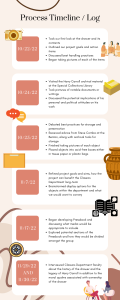
When we first encountered the objects in the drawer, we knew that they were in a state that was unsuitable for their preservation, but we were ignorant as to the best way to preserve them. From my internship at the Benton Museum of Art, the museum on campus, I knew that artifacts should always be handled with clean, dry hands. We decided against using latex gloves to handle the objects since I also learned from my internship that latex gloves make the wearer less sensitive to objects, and thus more likely to drop them. We established that the objects would only be taken between Professor Valentine’s office and the seminar room we worked in, and under no circumstances would we take them out of the building. While there were some objects in the drawer that were clearly not ancient pottery sherds, we kept them in the collection as they too are a part of the history. We also decided not to try to clean them, even though they were covered with dust.
On the first day we handled the objects, October 22, we laid all the pieces out and counted them, placing them on numbered sticky notes. On this day we also started photographing them with a Canon camera and shadow box. We discovered a large range of objects, most we recognized as potsherds, but there were a few rocks and pieces of obsidian, as well as a thumbtack and some pieces of paper. We chose to treat all the objects with equal care, whether we suspected they were antiquities or not.
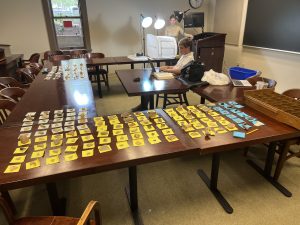
We then bought paper tags that we numbered and wrapped around each object. To avoid letting them gather more dust, we placed some in plastic bags and some in plastic cups before storing them in Professor Valentine’s office. The objects that were too small to have paper tags we placed in baggies with a numbered sticky note. It was not until later that we learned the adhesive on sticky notes could be harmful to the objects. Luckily, none of the adhesive had touched any of the objects directly, but we decided to do further research as to the best way to store the objects.
On October 25, I had a meeting with Steve Comba, the Associate Director and Registrar of the Benton Museum of Art, to discuss our project. He shared with me that it is not uncommon for colleges to find artifacts or cultural items that have been neglected. In fact, unaffiliated citizens of Claremont, after finding cultural artifacts, have left them at the doorstep of the college’s museum. In regards to our project, Steve suggested that we use less plastic bags, since plastic can be slippery and cause handlers to drop the objects. Instead, he gave us archival tissue paper to wrap the objects in, and he gave us an archival box to store them. Archival materials are acid-free, and thus will not cause damage to the objects they touch. They are standard for storing items in museums. Steve also advised us not to attempt to clean the objects, since without proper training we could damage them further. Karen Hudson, the collection manager at the Benton, then showed me how to wrap objects with tissue and label the tissue with pencil. She told me not to tape the tissue together and not to use ink. We implemented these tips the same day.
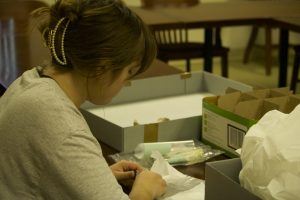
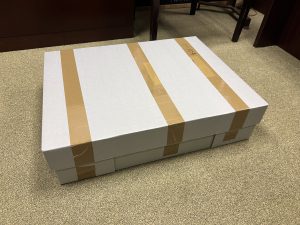
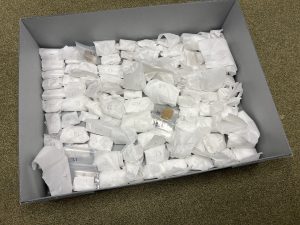
When I asked him what he thought about our project, Steve recommended that we examine some ethical questions: what is the benefit to keeping these objects? Should these objects be studied? When studying these objects, are we framing our findings as an opinion or an authoritative voice? Are we attempting to be a voice for a culture to which we do not belong? What is our responsibility to these objects and to the culture they come from? We tried to keep these questions in mind while making decisions about our project.

